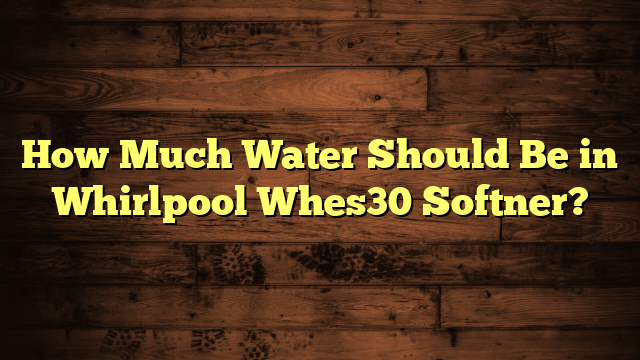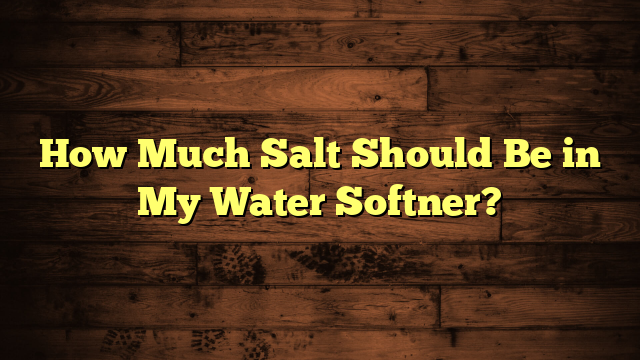How Much Water Pressure Does a Softner Lose?
Imagine a tree slowly losing its leaves in autumn; that's how your water pressure might feel when a softener's in play. You might wonder just how much pressure you're sacrificing for softened water. The truth is, the loss can vary greatly depending on several factors, including the type of softener you have. Understanding these dynamics is essential, as it can affect not just your water flow but also your overall system efficiency. What's the real impact on your daily routine? Let's explore this further.
Key Takeaways
- Water softeners typically experience pressure loss ranging from 3 to 25 PSI during the softening process.
- Smaller water softener units generally have lower pressure loss compared to larger units.
- Traditional ion exchange softeners may cause more noticeable pressure drops than salt-free softeners.
- Proper installation and maintenance can help minimize pressure loss in water softening systems.
- Monitoring a pressure gauge can aid in tracking pressure fluctuations associated with water softeners.
Understanding Water Pressure Basics
Water pressure is an essential factor in your home's plumbing system, directly impacting everything from shower performance to appliance efficiency. Understanding water pressure basics is vital for maintaining your plumbing.
Water pressure is measured in pressure units like pounds per square inch (PSI), which helps you gauge how well water flows through your pipes.
In most homes, a pressure range of 40 to 60 PSI is ideal. If your water pressure is too low, you might notice weak showers or slow-filling appliances. Conversely, excessively high pressure can strain your plumbing system, leading to leaks and costly repairs.
To check your water pressure, you can easily purchase a pressure gauge at a hardware store. Simply attach it to a faucet and turn on the water.
If your readings fall outside the best range, consider adjusting your pressure regulator or inspecting for issues like clogs or leaks.
Role of Water Softeners
A water softener plays an integral role in enhancing your home's water quality by reducing hardness minerals like calcium and magnesium. These minerals can cause scale buildup in your pipes and appliances, leading to decreased efficiency and costly repairs.
By investing in a water softener, you'll enjoy several water softener benefits, such as improved soap effectiveness, softer skin, and extended appliance lifespan.
Regular maintenance practices are vital for keeping your water softener running efficiently. You should regularly check the salt levels in the brine tank and clean the resin beads to prevent clogs and guarantee peak performance.
Moreover, scheduling periodic professional inspections can help identify potential issues before they escalate.
With a well-functioning water softener, you'll notice significant changes in your daily life. Your laundry will feel softer, your dishes will sparkle without spots, and your skin will thank you for the reduced dryness.
Factors Affecting Water Pressure
Several factors can affect the water pressure in your home, and understanding them is vital for peak performance of your water softener. One of the most significant factors is the size of your plumbing system. If your pipes are too narrow, they can restrict water flow, leading to reduced pressure.
Furthermore, the layout of your plumbing—such as bends and turns—can hinder ideal flow as well.
Another important element is the condition of your water softener. A dirty or clogged resin tank can negatively impact water flow, resulting in diminished pressure. Regular maintenance is key to keeping your softener functioning correctly.
You should also keep an eye on your pressure gauge, which helps you monitor any fluctuations in pressure levels.
Lastly, your home's overall water demand plays a role. If multiple fixtures are in use simultaneously, it can create competition for water flow, which may lower pressure at the softener.
Typical Pressure Loss Ranges
When it comes to typical pressure loss in water softeners, you'll find standard values that can vary based on several factors.
Understanding these ranges helps you know what to expect and how your system might perform under different conditions.
Standard Pressure Loss Values
Understanding standard pressure loss values in water softeners is essential for maintaining efficient water flow in your home. Typically, you'll find that standard values for pressure loss range from 3 to 25 psi, depending on the specific system and its configuration.
For instance, smaller units might experience lower pressure loss, while larger or more complex systems could have higher values.
It's important to note that pressure loss primarily occurs during the softening process, as water passes through the resin beads that remove hardness. Knowing these standard values helps you determine if your water softener is functioning effectively.
If you notice a significant drop in pressure beyond these standard values, it could indicate a problem needing your attention.
For a quick reference, many manufacturers provide charts that outline expected pressure loss based on flow rates and system size.
Factors Affecting Pressure Variability
Various factors can influence the pressure variability you experience with your water softener. One major factor is water flow. If your household has high water demand—like multiple showers running simultaneously—you may notice a drop in pressure.
Furthermore, the size of your plumbing can play a role; narrower pipes can restrict flow, leading to noticeable pressure losses.
Another aspect to take into account is the type of water softener you have. Different models and configurations can result in varying pressure levels. If your softener has a built-in bypass valve, using it can help maintain pressure during regeneration cycles.
Regular maintenance is also essential. A clogged filter or resin bed can impede water flow, which affects pressure. You can use a pressure gauge to monitor your water pressure regularly, helping you identify any significant drops over time.
Lastly, local water supply conditions can change, affecting overall pressure. Seasonal changes, such as droughts or heavy rainfall, can alter municipal water pressure, which might be reflected in your home's supply.
Measuring Pressure Drop Effect
Measuring the pressure drop effect in your water softener can provide valuable insights into its performance. To get started, you'll need to use pressure gauges, which are essential tools for accurate pressure measurement. These gauges help you determine the pressure before and after the water passes through the softener.
Typically, you can expect a pressure loss ranging from 5 to 15 psi, although this can vary based on the model and the water quality. If your readings exceed this range, it might indicate a clog or an issue with the softener's functionality. Regularly monitoring pressure helps you maintain peak performance, guaranteeing your system runs efficiently.
To measure effectively, install the gauges on both the inlet and outlet sides of the softener. This setup allows for a straightforward comparison. If you notice significant drops, it's time to reflect on maintenance or replacement options.
Keeping track of these pressure measurements not only aids in troubleshooting but also extends the life of your water softener. With the right approach, you can guarantee your system operates smoothly, providing you with softened water without unnecessary pressure loss.
Impact of Softener Type
When you choose a water softener, the type you select can greatly affect water pressure.
Ion exchange softeners often lead to a noticeable pressure drop due to their complex filtration process, while salt-free softeners typically maintain pressure better.
Understanding these differences helps you make an informed decision that suits your household needs.
Ion Exchange Softener Effect
While the type of ion exchange softener you choose can greatly influence your water pressure, understanding its impact is vital for enhancing your home's water system. The ion exchange mechanism plays a significant role in softener efficiency, and different types can lead to varying pressure outcomes.
Here are three key factors to evaluate:
- Resin Quality: Higher-quality resin beads can improve the ion exchange process, leading to better softening and less pressure drop.
- System Size: A correctly sized unit for your household needs guarantees peak performance. An oversized softener can cause unnecessary pressure loss.
- Maintenance: Regular maintenance, including resin cleaning and salt replenishment, helps maintain softener efficiency, minimizing pressure loss over time.
Choosing the right ion exchange softener involves balancing these factors to assure you get the best performance.
When you understand how your softener type affects water pressure, you can make informed decisions. Ultimately, this knowledge helps you enjoy better water quality without sacrificing flow, assuring your home remains comfortable and functional.
Salt-Free Softener Performance
A salt-free water softener offers an alternative approach to managing hardness without the use of sodium ions. This type of system doesn't remove minerals like calcium and magnesium; instead, it alters their structure, preventing scale buildup.
One of the notable salt-free advantages is that you won't have to worry about adding salt, which can be a hassle and adds to your water bill.
However, it's crucial to understand that there are also maintenance challenges associated with salt-free systems. While you won't need to regularly refill salt, you may encounter issues with sediment buildup in the unit, requiring periodic cleaning.
Furthermore, salt-free softeners may not be as effective in very hard water areas compared to traditional systems.
Importance of Proper Installation
Proper installation of a water softener is crucial for peak performance and efficiency. When setting up your system, you can't overlook the importance of proper alignment and effective installation techniques.
A well-installed water softener not only maximizes its functionality but also helps prevent potential issues down the line.
Here are three key considerations for proper installation:
- Correct Placement: Choose a location that allows easy access for maintenance and is close to the water supply. Avoid areas prone to extreme temperatures or flooding.
- Leveling the Unit: Make sure the softener is level during installation. Uneven placement can lead to improper functioning and might affect water pressure.
- Piping Connections: Use the right fittings and verify that all connections are secure. Leaky joints can result in pressure loss, undermining the softener's effectiveness.
Solutions to Minimize Pressure Loss
Making sure your water softener is installed correctly sets the stage for peak performance, but addressing pressure loss requires additional strategies.
First, focus on pressure maintenance. Regularly checking and cleaning your system's filters can notably improve efficiency. Clogged filters restrict water flow, leading to reduced pressure.
Next, consider adjusting the settings on your softener. Sometimes, simply tweaking the regeneration frequency can help maintain ideal pressure. If your system uses a timer, make certain it regenerates during off-peak hours to maximize water availability.
You might also look into system upgrades. Newer models often come equipped with advanced technology designed to minimize pressure loss. If your softener is older, investing in a modern unit could save you time and hassle in the long run.
Additionally, check the plumbing leading to and from your softener. Older pipes can cause bottlenecks, so replacing them with larger-diameter pipes can improve flow and pressure.
When to Consult a Professional
Recognizing when to consult a professional is essential for maintaining your water softener's efficiency. While you may handle some basic pressure troubleshooting on your own, there are certain situations where expert help is vital.
If you encounter any of the following, it's time to call in a professional for an inspection:
- Significant Pressure Drops: If you notice a sudden and noticeable decrease in water pressure, this could indicate a serious issue with your water softener or plumbing system.
- Persistent Error Codes: Many modern water softeners display error codes. If your unit shows persistent errors despite your attempts to reset or troubleshoot, seek professional assistance.
- Unusual Noises or Leaks: Strange sounds or visible leaks around your softener can point to mechanical problems that require professional inspection to prevent further damage.
Don't hesitate to reach out for help when needed. Consulting a professional can save you time and money in the long run, ensuring your water softener operates at peak performance.
Frequently Asked Questions
Can Water Softeners Affect Water Temperature?
Yes, water softeners can affect water temperature. When you use a softener, it may alter how efficiently your water heater operates, potentially making the water temperature feel different. You should monitor changes closely.
How Often Should I Maintain My Water Softener?
Sure, smooth sailing starts with steadfast water softener maintenance! You should perform routine maintenance every few months. Check salt levels, clean the brine tank, and inspect the system for ideal performance and longevity. Stay ahead of problems!
What Is the Lifespan of a Water Softener?
A water softener typically lasts 10 to 15 years with proper maintenance. Regular water softener maintenance guarantees ideal performance, maximizing water softener benefits like improved efficiency and extended lifespan for your home's plumbing system.
Do Water Softeners Require Electricity to Operate?
Imagine a silent machine, waiting. You'll find that most water softeners need electricity to power their components. Without a reliable power source, their efficient operation falters, leaving your water hard and unyielding.
Can I Install a Water Softener Myself?
Yes, you can install a water softener yourself with some DIY installation skills. Just follow the instructions carefully to guarantee the best water quality. Make sure you have the right tools and materials before starting the project.
Conclusion
In conclusion, understanding how much water pressure a softener can lose helps you make informed decisions about your system. While it's common to see drops between 3 to 25 PSI, the type of softener and its installation play essential roles. Remember, "A stitch in time saves nine" – regular maintenance can keep your water pressure in check. If you notice significant pressure loss, don't hesitate to consult a professional to guarantee your softener runs efficiently.







